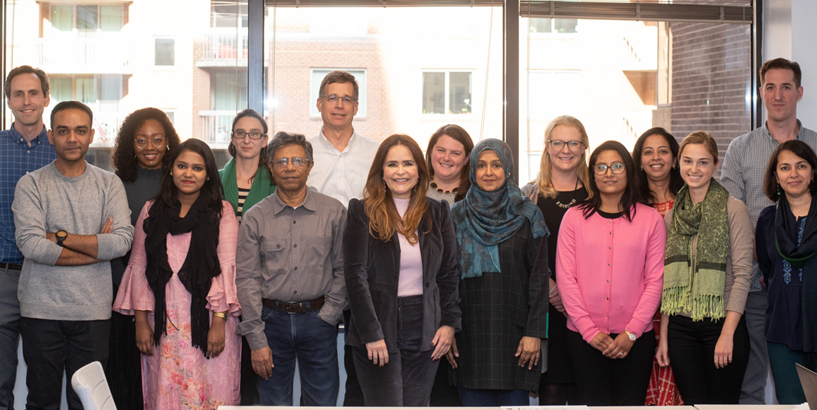Typhoid conjugate vaccines (TCVs) can significantly reduce typhoid incidence in endemic communities. For policymakers in countries considering TCV introduction, accurate data are needed to inform the decision-making process. New data from the Surveillance for Enteric Fever in Asia Project (SEAP) confirm that enteric fever – typhoid and paratyphoid – causes a high burden of disease in Dhaka, Bangladesh; Kathmandu and Kavre, Nepal; and Karachi, Pakistan.
In 2014, the Sabin Vaccine Institute initiated SEAP with partners at Aga Khan University in Pakistan, the Child Health Research Foundation in Bangladesh, Dhulikhel Hospital in Nepal, Stanford University and the Centers for Disease Control & Prevention in the United States. SEAP was designed as a two-phased project to track enteric fever disease burden and generate data to inform policy decisions in Asia and worldwide. Phase I included a retrospective data review of enteric fever cases. SEAP Phase II employed a hybrid surveillance approach using two data sources: prospective surveillance in hospital sites and community surveys of healthcare-seeking behavior. The program combined these two sources to generate incidence estimates for the burden of typhoid and paratyphoid in study communities.
Data from SEAP Phase II were published in The Lancet Global Health. We connected with two of the paper’s co-authors, Dr. Denise Garrett from Sabin Vaccine Institute, and Ashley Longley from the Centers for Disease Control and Prevention, to discuss the project’s latest findings.
What did Phase II of the SEAP project focus on, and why is it important to our understanding of enteric fever burden?
During SEAP Phase I the investigators conducted a retrospective review of existing enteric fever data from our study site hospitals. Phase II, from 2016-2019, was designed prospectively: we recruited patients with fever and collected blood for diagnostic testing. We were also able to collect demographic, risk factor, illness, and follow-up data from our participants for more robust information. Phase II gave us a comprehensive understanding of the enteric fever burden within our sites. In addition to incidence, we were able to understand severity of illness, antimicrobial resistance, cost of illness, and much more. The Phase II data will help policymakers make decisions about typhoid prevention and control.
What are some of the key takeaways of these data?
Phase II data indicated a substantial burden of enteric fever at all participating sites, particularly among children. We found a high incidence of typhoid in children aged 2 years and younger. This finding underscores the importance of the WHO recommendation for TCV for children as young as 6 months old. These data tell us that the youngest children are falling ill with typhoid and need to be protected with TCVs. Additionally, we found a high incidence of patients hospitalized with typhoid, indicating considerable morbidity and economic impact. These data reiterate the timely need for TCV introduction to reduce the health system resources needed for long in-patient treatments.
All study participants received treatment at a clinic or hospital. Outside of the study, not all who get enteric fever have access to care. How does the study account for cases of enteric fever that never go to a doctor?
We know not all people with typhoid go to a doctor or a clinic, and even those who do may not receive a reliable diagnostic test. Since the study only enrolled eligible, febrile patients who sought care at hospitals, the study teams also conducted healthcare utilization surveys in the catchment areas of the study site hospitals. To identify the true burden of disease, which includes those who did not present at a hospital, the teams went to different households within the communities. The team asked households about febrile illness and when, why, and where they go to seek medical care. With this information, we could statistically adjust our findings to estimate the true burden of enteric fever in the community.
Two of the three countries in this study (Nepal and Pakistan) have introduced TCV, with Bangladesh poised to do so soon. How does this data impact future decisions or policies?
SEAP Phase II generated data before these countries decided to introduce TCV. The surveillance provided evidence that supported vaccine introduction decisions. Pakistan introduced TCV in 2019 and Nepal in April 2022. We will continue to collect data in SEAP Phase III, which will provide data from the same Phase II sites following TCV introduction. All these data will help to inform future decisions on enteric fever control and prevention measures in the region.
The study collected data for both typhoid and paratyphoid and found high incidence of typhoid, but not as high for paratyphoid. Why is it important to track paratyphoid as well?
While typhoid and paratyphoid cause enteric fever, TCV only protects against typhoid. It’s important to track paratyphoid as well to so that decision-makers have burden data available when the S. Typhi and S. Paratyphi A bivalent vaccines, which are still in development, ultimately become available. The paratyphoid data also influence decisions about non-vaccine interventions, including improvements to water, sanitation, and hygiene programs.
What recommendations do you have for enteric fever surveillance and prevention going forward?
Routine surveillance can provide invaluable data for understanding enteric fever – from who gets sick and how sick they get, to profiles of drug resistance and disease type. It also offers us a chance to see how these factors change over time and with what interventions. With robust data, we can better understand how to prevent enteric fever.



